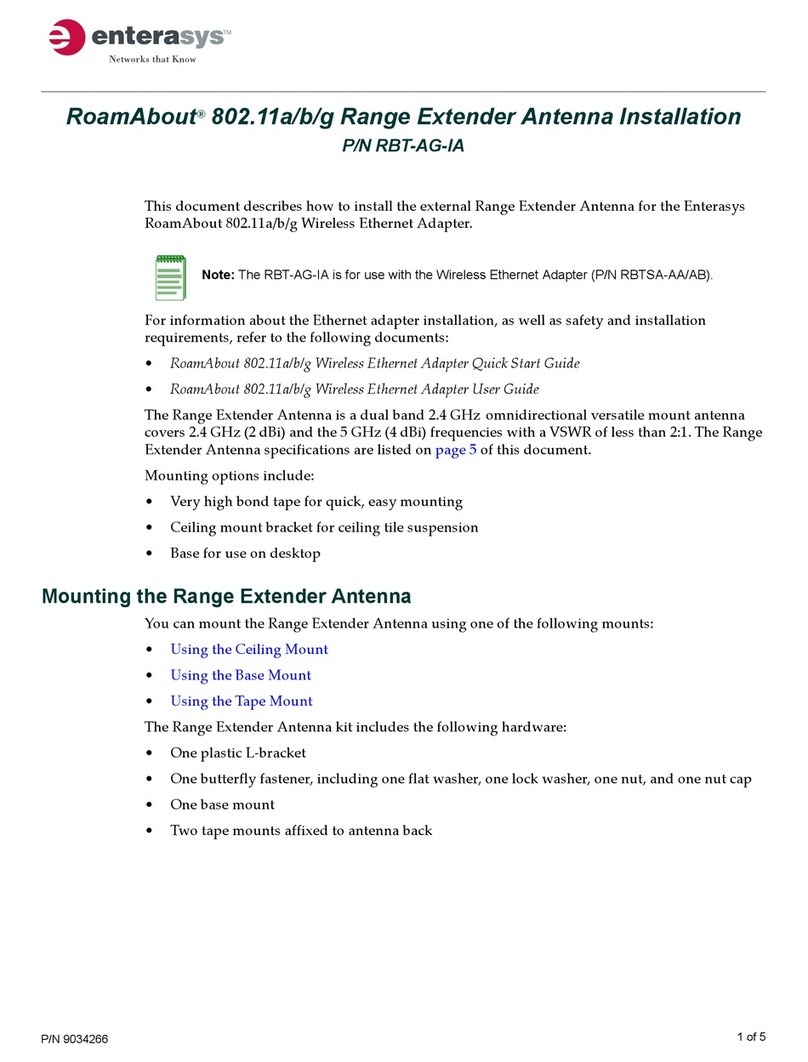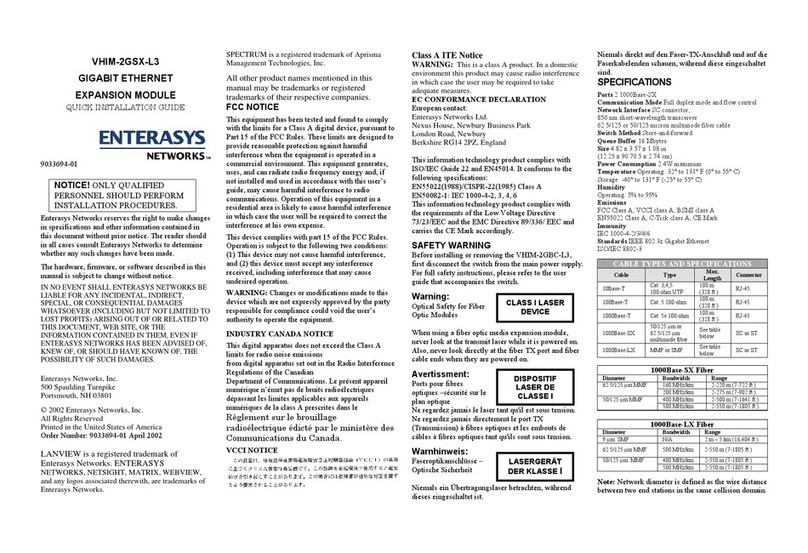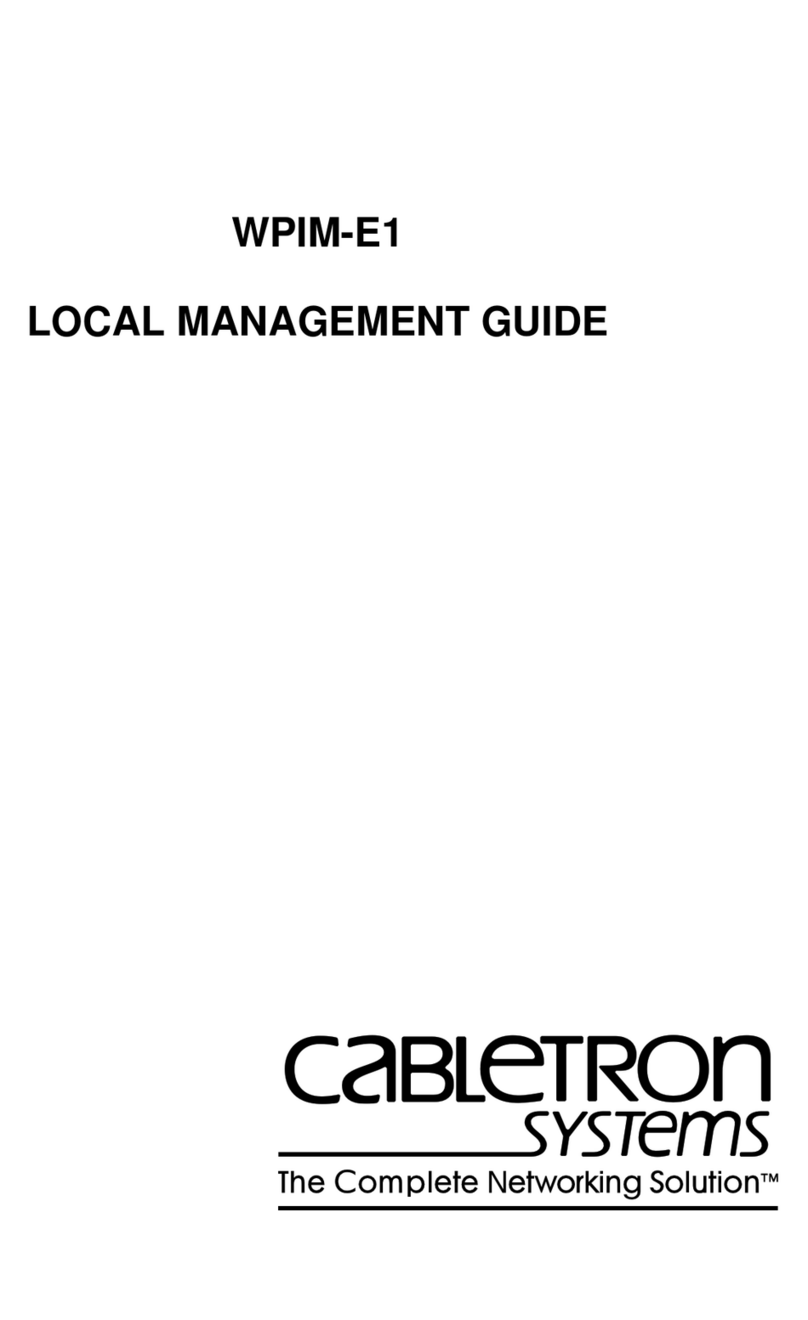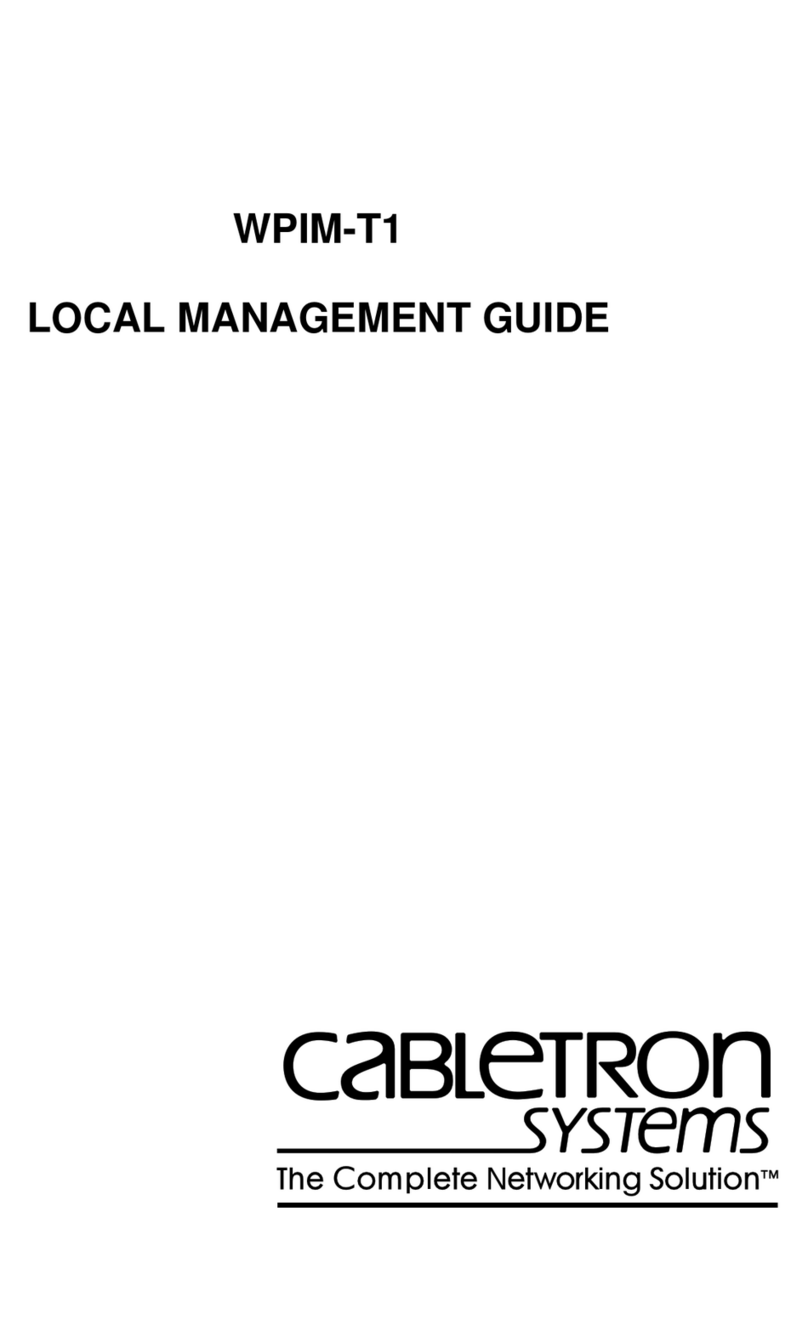Niemals direkt auf den Faser-TX-Anschluß und auf die
Faserkabelenden schauen, während diese eingeschaltet
sind.
EC CONFORMANCE DECLARATION
All other product names mentioned in this manual may
be trademarks or registered trademarks of their
respective companies.
VHIM-2GBC-L3 European contact:
Enterasys Networks Ltd.
GIGABIT ETHERNET FCC NOTICE SPECIFICATIONS
Nexus House, Newbury Business Park
London Road, Newbury
This equipment has been tested and found to comply
with the limits for a Class A digital device, pursuant to
Part 15 of the FCC Rules. These limits are designed to
provide reasonable protection against harmful
interference when the equipment is operated in a
commercial environment. This equipment generates,
uses, and can radiate radio frequency energy and, if
not installed and used in accordance with this user’s
guide, may cause harmful interference to radio
communications. Operation of this equipment in a
residential area is likely to cause harmful interference
in which case the user will be required to correct the
interference at his own expense.
EXPANSION MODULE Ports 2 GBIC
Berkshire RG14 2PZ, England Communication Mode Full duplex mode and flow control
QUICK INSTALLATION GUIDE Network Interface GBIC connector,
This information technology product complies with
ISO/IEC Guide 22 and EN45014. It conforms to the
following specifications:
850 nm short-wavelength transceiver for SX
1310 nm long-wavelength transceiver for LX
62.5/125 or 50/125 micron multimode fiber cable
Switch Method Store-and-forward
EN55022(1988)/CISPR-22(1985) Class A Size 4.82 x 3.57 x 1.08 in.
EN50082-1: IEC 1000-4-2, 3, 4, 6 (12.25 x 90.70.5 x 2.74 cm)
This information technology product complies with
the requirements of the Low Voltage Directive
73/23/EEC and the EMC Directive 89/336/ EEC and
carries the CE Mark accordingly.
9033696-01 Power Consumption 2.4W maximum
Temperature Operating: 32° to 131° F (0° to 55° C)
NOTICE! ONLY QUALIFIED
PERSONNEL SHOULD PERFORM
INSTALLATION PROCEDURES.
Storage: -40° to 131° F (-25° to 55° C)
Humidity
Operating: 5% to 95%
SAFETY WARNING Emissions
This device complies with part 15 of the FCC Rules.
Operation is subject to the following two conditions:
(1) This device may not cause harmful interference,
and (2) this device must accept any interference
received, including interference that may cause
undesired operation.
Before installing or removing the VHIM-2GBC-L3,
first disconnect the switch from the main power supply.
For full safety instructions, please refer to the user
guide that accompanies the switch.
FCC Class A, VCCI class A, BSMI class A
Enterasys Networks reserves the right to make changes
in specifications and other information contained in
this document without prior notice. The reader should
in all cases consult Enterasys Networks to determine
whether any such changes have been made.
EN55022 Class A, C-Tick class A, CE Mark
Immunity
IEC 1000-4-2/3/4/6
Standards IEEE 802.3z Gigabit Ethernet
ISO/IEC 8802-3
BGICs are a Class 1 laser device. Use only modules
approved by the switch manufacturer. These modules
are compliant to the following standards:
The hardware, firmware, or software described in this
manual is subject to change without notice. CABLE TYPES AND SPECIFICATIONS
Cable Type Max.
Length Connector
10Base-T Cat. 3,4,5
100-ohm UTP
100 m
(328 ft.) RJ-45
100Base-T Cat. 5 100-ohm 100 m
(328 ft.) RJ-45
1000Base-T Cat. 5e 100-ohm 100 m
(328 ft.) RJ-45
1000Base-SX
50/125 µm or
62.5/125 µm
multimode fiber
See table
below SC or ST
1000Base-LX MMF or SMF See table
below SC or ST
WARNING: Changes or modifications made to this
device which are not expressly approved by the party
responsible for compliance could void the user’s
authority to operate the equipment.
EN60825-1, EN60825-2 and IEC825-1, IEC825-2.
IN NO EVENT SHALL ENTERASYS NETWORKS BE
LIABLE FOR ANY INCIDENTAL, INDIRECT,
SPECIAL, OR CONSEQUENTIAL DAMAGES
WHATSOEVER (INCLUDING BUT NOT LIMITED TO
LOST PROFITS) ARISING OUT OF OR RELATED TO
THIS DOCUMENT, WEB SITE, OR THE
INFORMATION CONTAINED IN THEM, EVEN IF
ENTERASYS NETWORKS HAS BEEN ADVISED OF,
KNEW OF, OR SHOULD HAVE KNOWN OF, THE
POSSIBILITY OF SUCH DAMAGES.
CLASS I LASER
DEVICE
Warning:
Optical Safety for Fiber
Optic Modules
INDUSTRY CANADA NOTICE
This digital apparatus does not exceed the Class A
limits for radio noise emissions
When using a fiber optic media expansion module,
never look at the transmit laser while it is powered on.
Also, never look directly at the fiber TX port and fiber
cable ends when they are powered on.
from digital apparatus set out in the Radio Interference
Regulations of the Canadian
Department of Communications. Le présent appareil
numérique n’émet pas de bruits radioélectriques
dépassant les limites applicables aux appareils
numériques de la class A prescrites dans le Règlement
sur le brouillage radioélectrique édicté par le ministère
des Communications du Canada.
1000Base-SX Fiber
Diameter Bandwidth Range
160 MHz/km 2-220 m (7-722 ft.)62.5/125 µm MMF
200 MHz/km 2-275 m (7-902 ft.)
400 MHz/km 2-500 m (7-1641 ft.)50/125 µm MMF
500 MHz/km 2-550 m (7-1805 ft.)
Enterasys Networks, Inc.
500 Spaulding Turnpike
Portsmouth, NH 03801
2002 Enterasys Networks, Inc.
All Rights Reserved
Printed in the United States of America
Order Number: 9033696-01 April 2002
LANVIEW is a registered trademark of Enterasys
Networks. ENTERASYS NETWORKS, NETSIGHT,
MATRIX, WEBVIEW, and any logos associated
therewith, are trademarks of Enterasys Networks.
SPECTRUM is a registered trademark of Aprisma
Management Technologies, Inc.
VCCI NOTICE
Class A ITE Notice
WARNING: This is a class A product. In a domestic
environment this product may cause radio interference
in which case the user may be required to take
adequate measures.
Avertissment:
Ports pour fibres
optiques –sécurité sur le
plan optique
Ne regardez jamais le laser tant qu'il est sous tension.
DISPOSITIF
LASER DE
CLASSE I
Ne regardez jamais directement le port TX
(Transmission) à fibres optiques et les embouts de
câbles à fibres optiques tant qu'ils sont sous tension.
1000Base-LX Fiber
Diameter Bandwidth Range
9 µm SMF N/A 2 m – 5 km (16,404 ft.)
62.5/125 µm MMF 500 MHz/km 2-550 m (7-1805 ft.)
400 MHz/km 2-550 m (7-1805 ft.)50/125 µm MMF
500 MHz/km 2-550 m (7-1805 ft.)
LASERGERÄT
DER KLASSE I
Warnhinweis:
Faseroptikanschlüsse –
Optische Sicherheit
Note: Network diameter is defined as the wire distance
between two end stations in the same collision domain.
Niemals ein Übertragungslaser betrachten, während
dieses eingeschaltet ist.

























